Takoyaki, or Grilled Octopus Balls, originated in Osaka and are one of Japan’s best-known street foods. Whether you make a traditional style with bits of octopus or choose creative alternatives, these ball-shaped dumplings are fun to make with your friends and family!
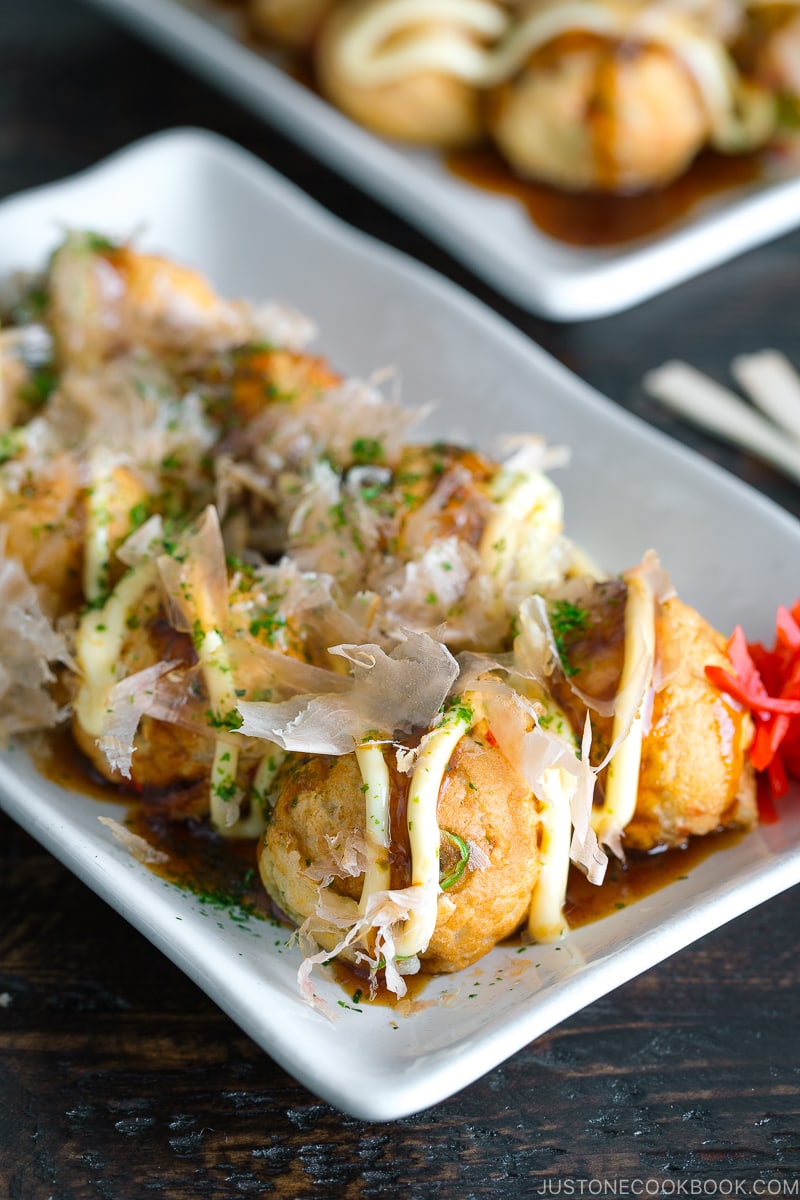
Takoyaki (たこ焼き) is a Japanese snack in the shape of little round balls containing pieces of octopus. Tako-yaki literally translates to “octopus-grilled/fried” and some people may call it “Grilled Octopus Balls” or “Octopus Dumplings”.
What is Takoyaki
Here are some facts about takoyaki.
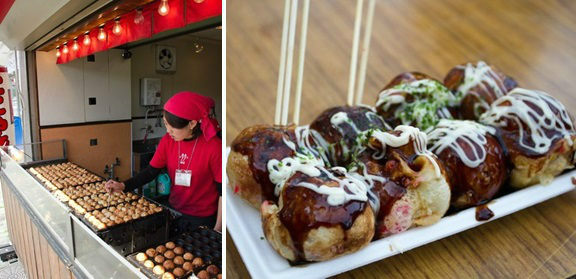
- It originated and became popular in Osaka around 1935 (according to wiki) and then spread to greater south-central Japan and beyond.
- It’s one of the most popular Japanese street foods along with Okonomiyaki.
- Takoyaki is usually sold by street vendors, convenience stores, supermarkets, food courts, and of course specialty restaurants. In Osaka, takoyaki stands can be easily found throughout the city.
- It is usually served with slightly salty takoyaki sauce, which goes well with beer and other alcoholic drinks. Therefore, many Izakaya restaurants serve takoyaki on the menu.
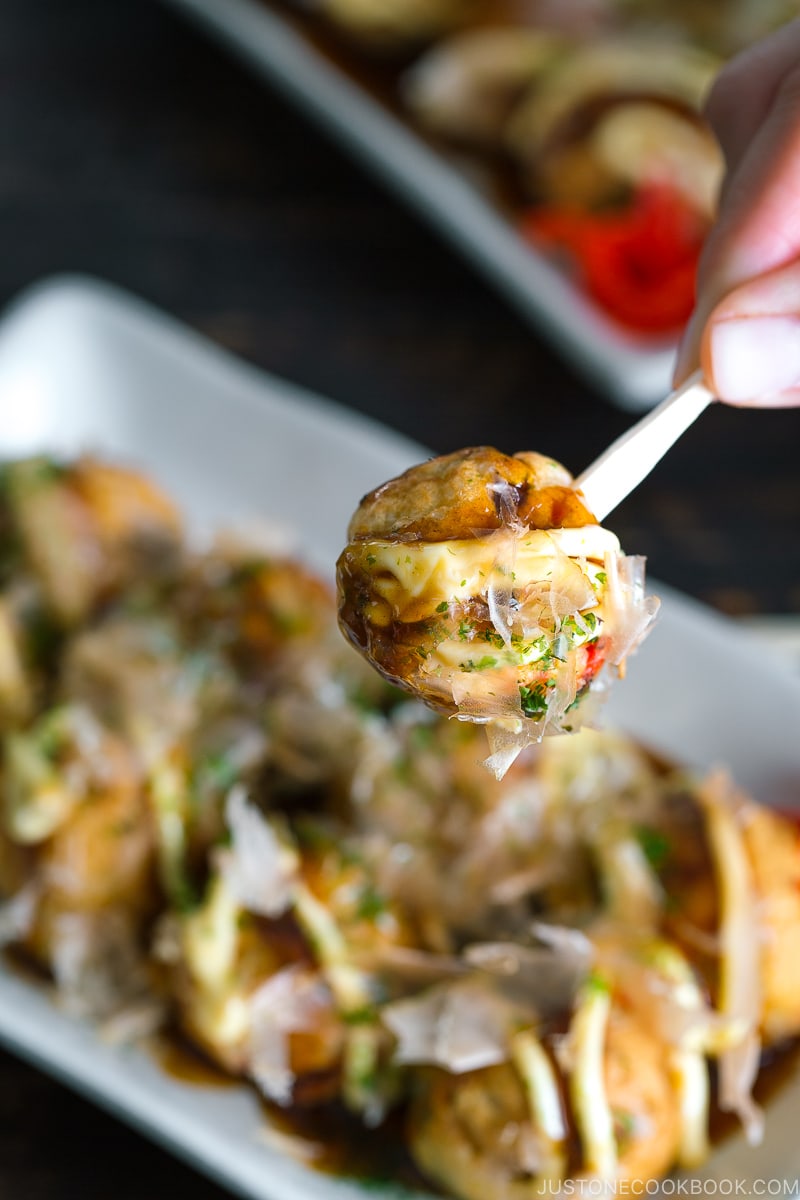
5 Ingredients for Authentic Takoyaki
There are so many variations of takoyaki throughout Japan. For example, the original Osaka-style does not include any cabbage, but many regional variations (Kyoto, Kobe, Nagoya, Tokyo areas) do. Even though I lived in the Tokyo area, I actually didn’t know they sometimes contain cabbage till now.
Here are the ingredients for the classic takoyaki recipe.
1. Dashi-flavored batter
Very simple. It’s a mixture of Japanese stock Dashi, all-purpose flour, baking powder, eggs, salt, and soy sauce. If you don’t want to make the batter from scratch, you can find takoyaki mix in Japanese grocery stores or Amazon.
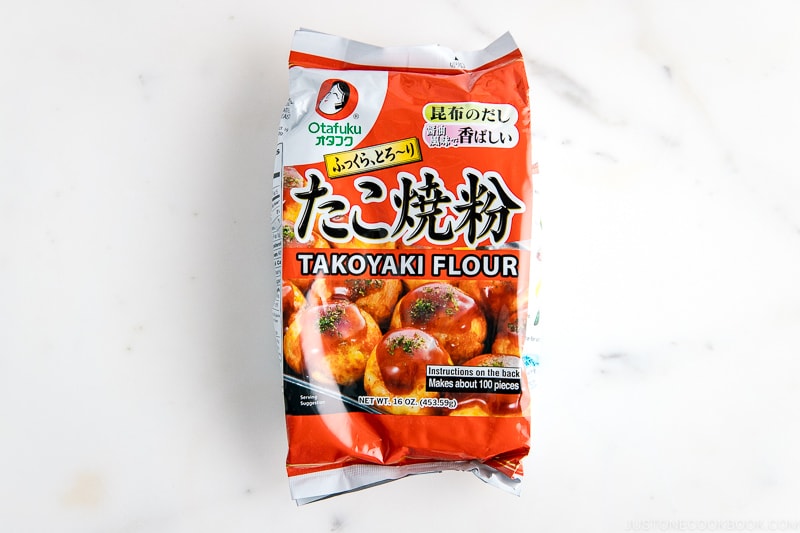
2. Octopus
You can purchase cooked (boiled) octopus (tako in Japanese) in Japanese grocery stores. If you are going to make this snack for a big party, you can purchase a whole cooked octopus at an online sashimi store like Catalina Offshore. When I buy a whole octopus, I use it for different dishes, including sashimi, carpaccio, octopus salad (Takosu), and of course, takoyaki.
3. Beni shoga (pickled red ginger)
Small bits of beni shoga (紅生姜), or red pickled ginger, give a nice pop on the color of takoyaki and a little spicy, pungent kick to the dish.
4. Green onion
The batter is yellow, octopus, and beni shoga are red… and now you need green color to make the dish look more appetizing (and delicious)!
5. Tenkasu or Agedama (Tempura scraps)
I often get questions about what Tenkasu does for the dish. We use tempura scraps for hot or cold Tanuki Udon Noodles and Okonomiyaki (even Hiroshima-style). The oil from Tenkasu adds richer and umami flavors, and additional crispness and creaminess inside takoyaki balls.
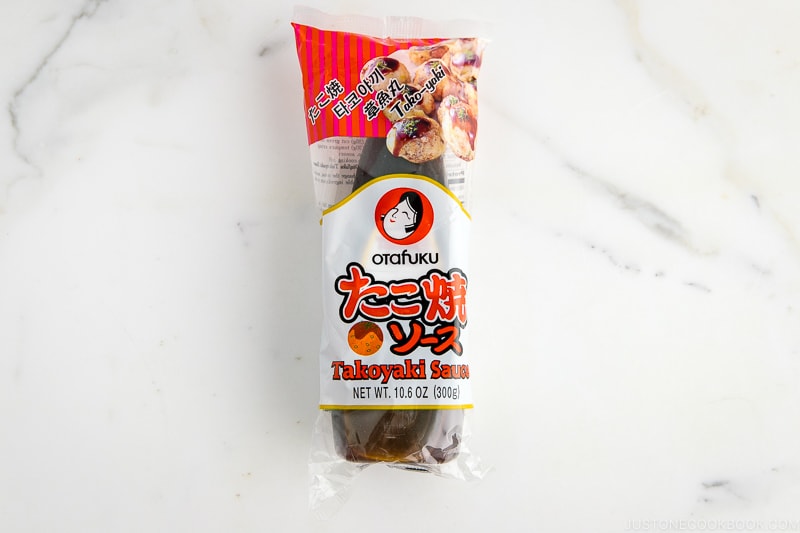
Takoyaki Sauce & Garnish
Takoyaki is served with Worcestershire sauce-like “takoyaki sauce”, followed by some squirt of Japanese mayo. You can:
- Buy a store-bought takoyaki sauce
- Make a quick homemade takoyaki sauce (recipe) with several condiments
Then it’s topped with a sprinkle of a few garnishes:
- Aonori (dried green seaweed)
- Katsuobushi (dried bonito flakes)
3 Tips to Make Perfect Takoyaki
I received many requests for this recipe from JOC Readers (thank you!). To make the recipe as authentic as possible, I asked my best friend Yukako who lives in Osaka. She makes delicious takoyaki at home and she and her husband shared their own recipe with me and JOC readers. Yay! I adapted the recipe a little bit so that some ingredients will be easier to measure.
Tip 1: Don’t be stingy with the oil.
Apply generous oil everywhere (each hole in the takoyaki pan and surrounding flat area). How generous? You should see 1/4 inch (5 mm) oil in each hole. The oil helps takoyaki to have crispy skin and it’ll be easier for you to flip without the batter being stuck.
Tip 2: Generously pour the batter.
When you see smoke coming out of the grill/plate, fill the hole with the batter. If it overflows, that’s okay. Because the entire grill top should be covered with the batter after adding octopus and other ingredients in the hole. If you use a bigger chunk of octopus pieces, you might want to pour just enough to the top of the holes. As soon as the octopus goes in, it overflows naturally.
Tip 3: Flip 90 degrees and stuff in the extra batter.
Break the extra batter around the hole with skewers. Once the bottom of the takoyaki balls is crispy, rotate 90 degrees to let the uncooked batter pour out into the hole. Stuff and push in the extra surrounding dough inside the balls. This will help make a perfectly round shape.
For a home takoyaki grill, each hole doesn’t provide the same amount of heat. Therefore, it’s important to switch around the balls once they are in a ball shape so they’re browned evenly.
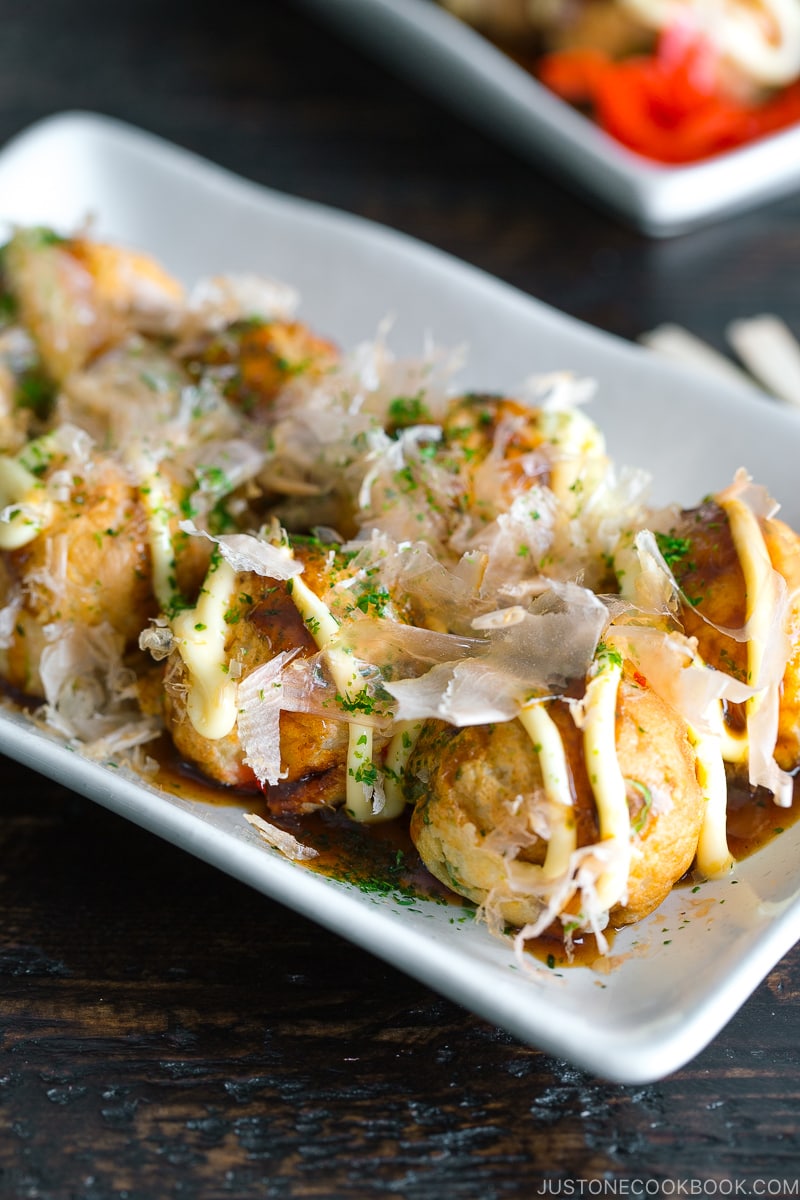
Don’t Like Octopus? Here Are Substitutions!
No problem! A lot of Japanese children enjoy different fillings besides pieces of octopus. Here are my suggestions for other fillings.
- Sausages / Bacon
- Canned tuna / Mentaiko (Spicy cod/pollock roe)
- Shrimp / Squid
- Cheese
- Mochi (rice cakes)
- Fish cake (chikuwa/crab sticks)
- Kimchi
- Corn
- Edamame
- Green peas
- Avocado
Various Takoyaki Grills
1. Zojirushi Gourmet Sizzler Electric Griddle + EA-YBC01 Takoyaki Plate (Optional) ($130 + $60)
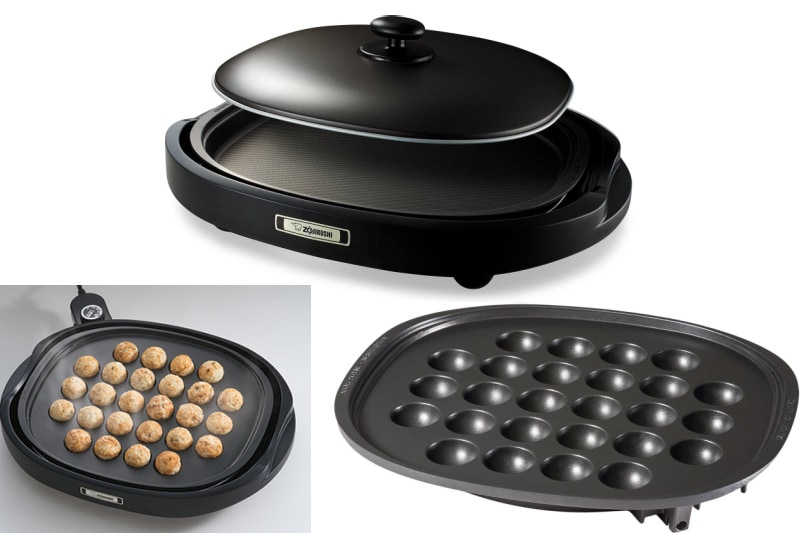
This is the takoyaki grill pan that I use. I use this electric griddle for Teppanyaki and Okonomiyaki. I switch the hot plate to the takoyaki plate when I make Takoyaki.
2. Iwatani Cassette Gas Takoyaki Device ($100)
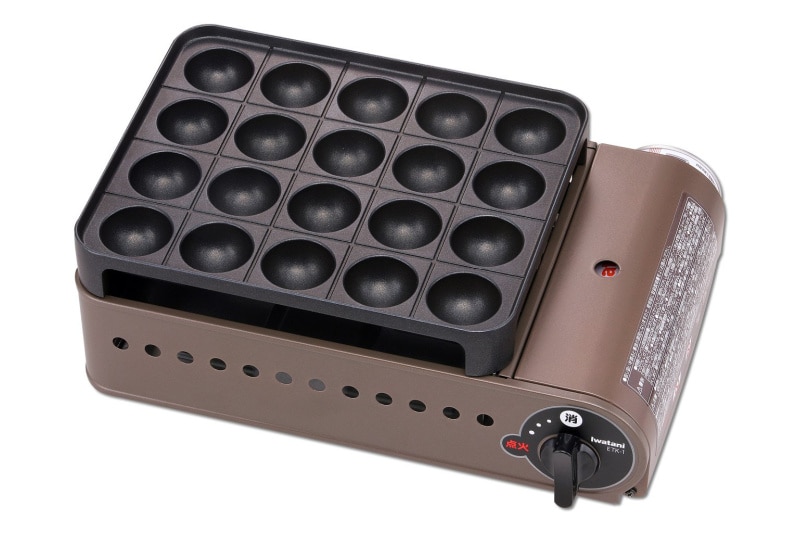
3. Iwatani Non-Stick Takoyaki Grill for Cassette Butane Stove ($40)
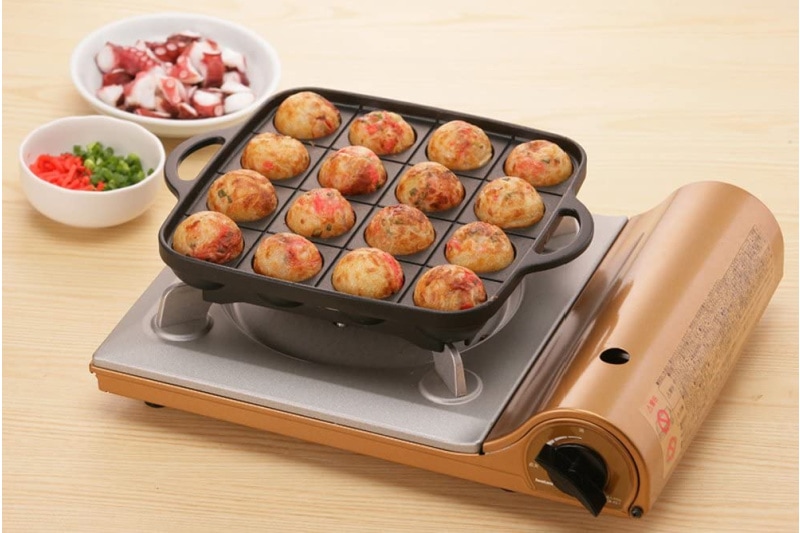
Do you have this Iwatani cassette feu butane stove already? I use this exact model for doing a hot pot at the table and sometimes filming my YouTube videos. If you have one already, then you can purchase this Iwatani accessory. The grill is non-stick and prevents food from sticking to the pan.
4. Yamazen Takoyaki Device ($45)
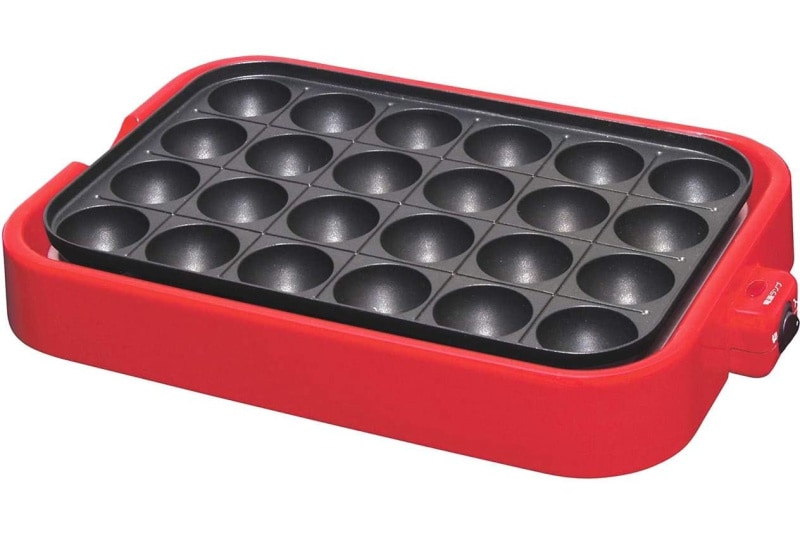
5. Ebelskiver (Danish) Pan ($25)
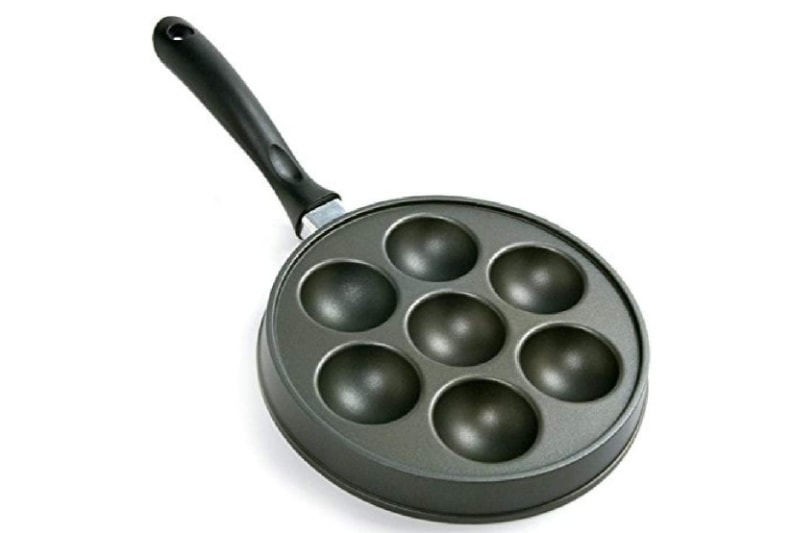
Many JOC readers told me they successfully made takoyaki with an Ebelskiver (Danish) pan or Appam Maker (Indian) as well.
Other Japanese Street Foods
- Yakisoba
- Okonomiyaki
- Taiyaki
- If you are interested in learning about Japanese Street Foods, check out Japanese Summer Festival Foods.
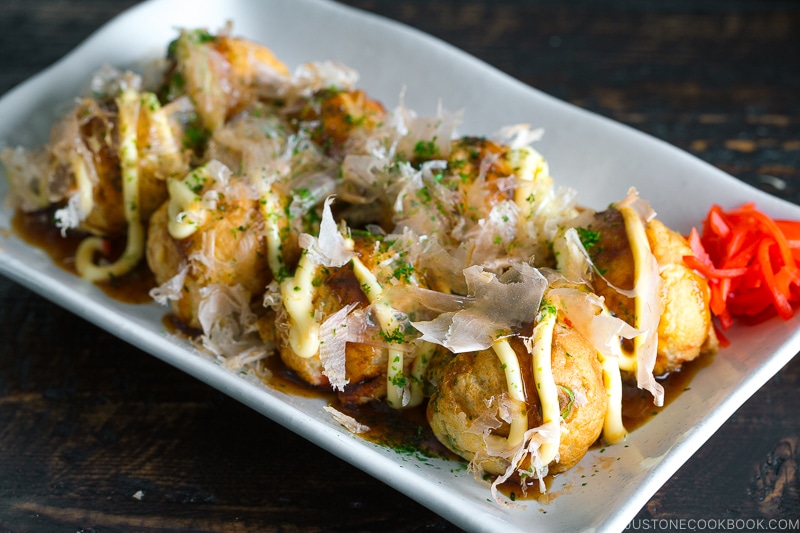
Wish to learn more about Japanese cooking? Sign up for our free newsletter to receive cooking tips & recipe updates! And stay in touch with me on Facebook, Pinterest, YouTube, and Instagram.
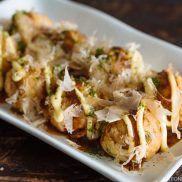
Takoyaki (Grilled Octopus Balls)
Video
Ingredients
- ¼ cup katsuobushi (dried bonito flakes) (I use the type with bigger flakes)
- 2 green onions/scallions
- 1 Tbsp pickled red ginger (beni shoga or kizami beni shoga) (store bought or make homemade Beni Shoga)
- 4.2 oz octopus sashimi (boiled octopus) (found in Japanese grocery stores; or substitute with sausage, corn, edamame, cheese, small mochi pieces…the choices are endless!)
For the Batter
- 1 cup all-purpose flour (plain flour)
- 2 tsp baking powder
- ½ tsp Diamond Crystal kosher salt
- 2 large eggs (50 g each w/o shell)
- 1 tsp soy sauce
- 1½ cups dashi (Japanese soup stock) (use standard Awase Dashi, dashi packet or powder, or Vegan Dashi)
For Cooking
- 2 Tbsp neutral oil
- ⅓ cup tenkasu/agedama (tempura scraps)
For the Toppings
Instructions
- Gather all the ingredients.
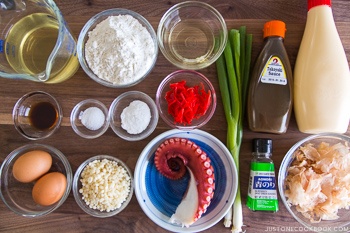
To Prepare the Filling
- Grind ¼ cup katsuobushi (dried bonito flakes) into a fine powder. Set aside to use during cooking.
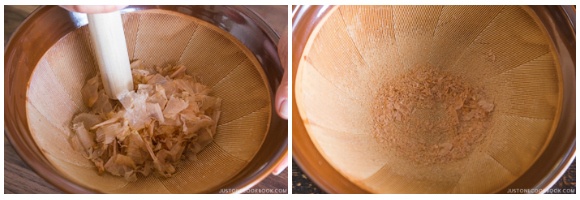
- Cut 2 green onions/scallions into thin slices and mince 1 Tbsp pickled red ginger (beni shoga or kizami beni shoga).
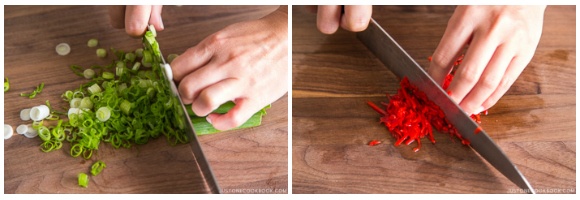
- Cut 4.2 oz octopus sashimi (boiled octopus) into bite-sized pieces about ½ inch (1.3 cm); I use the rangiri cutting technique. Tip: Cut it into smaller pieces so it's easier to chew, especially for kids.
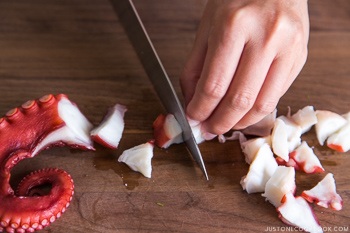
To Make the Batter
- Combine 1 cup all-purpose flour (plain flour), 2 tsp baking powder, and ½ tsp Diamond Crystal kosher salt in a large mixing bowl. Whisk it all together.
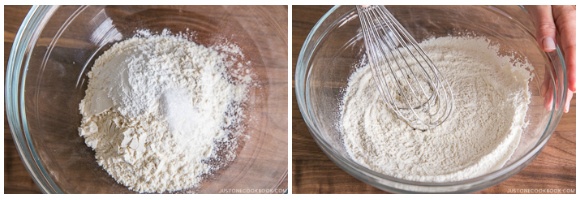
- Add 2 large eggs (50 g each w/o shell), 1 tsp soy sauce, and 1½ cups dashi (Japanese soup stock) to the bowl.
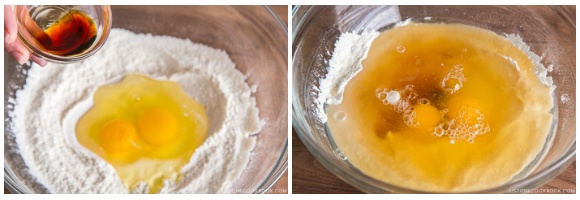
- Whisk until well blended. Transfer it to a handled measuring cup or any pitcher with a spout for easy pouring.
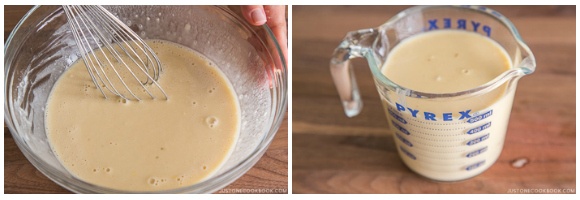
To Cook the Takoyaki
- Heat the takoyaki pan to 400ºF (200ºC) over medium heat. Use a brush to generously grease the rounded chambers and flat top surface with 2 Tbsp neutral oil. When the oil starts to smoke, pour the batter to fill the chambers. It’s okay to slightly overfill the cavities. In the next steps, the batter will likely overflow as you add more ingredients to it.
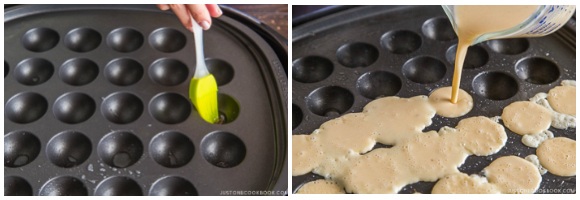
- Add 1–3 octopus pieces, depending on their size, to each chamber and sprinkle the ground katsuobushi powder on top.
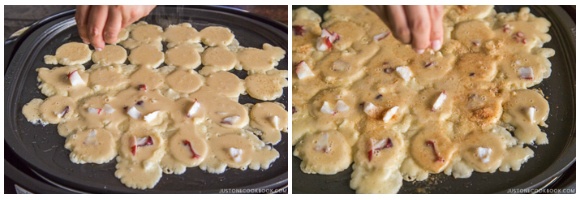
- Sprinkle ⅓ cup tenkasu/agedama (tempura scraps), the green onion slices, and the chopped pickled red ginger on top. After 3 minutes or so, when the batter on the bottom has set and is slightly crisp, use skewers to break the connected batter on top between the chambers. Rotate each piece 90 degrees (a quarter turn) toward the bottom of the pan. Stuff the connected dough back into the ball as you turn; the uncooked batter will flow out from inside to create another side of the ball. After you finish turning them, set a timer for 4 minutes.
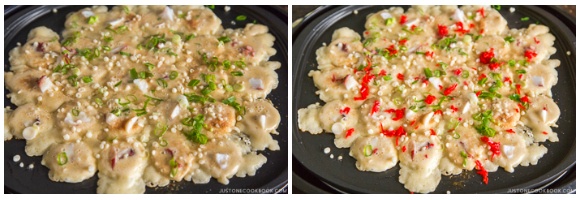
- After 4 minutes, rotate them again, starting with the first ball. Turn each takoyaki another 90 degrees toward the bottom of the pan so the remaining uncooked batter pours out into the chamber to complete the ball shape. Home takoyaki griddles don‘t distribute heat evenly, so it’s a good idea to swap the balls around to different chambers so they brown evenly. After turning and cooking for another 4 minutes, they are done.
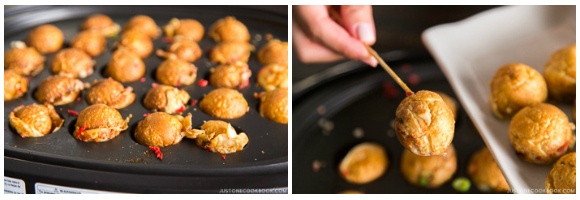
To Serve
- Transfer them onto a plate and drizzle with ½ cup takoyaki sauce and Japanese Kewpie mayonnaise. Sprinkle with katsuobushi (dried bonito flakes) and aonori (dried green laver seaweed) and serve with a side of pickled red ginger (beni shoga or kizami beni shoga). Serve immediately. (But, be careful—they‘re VERY hot inside!)

To Store
- You can keep the leftovers in an airtight container and store in the refrigerator for 3 days or in the freezer for 2–3 weeks.
Nutrition
Editor’s Note: The post was originally published on Oct 20, 2013.
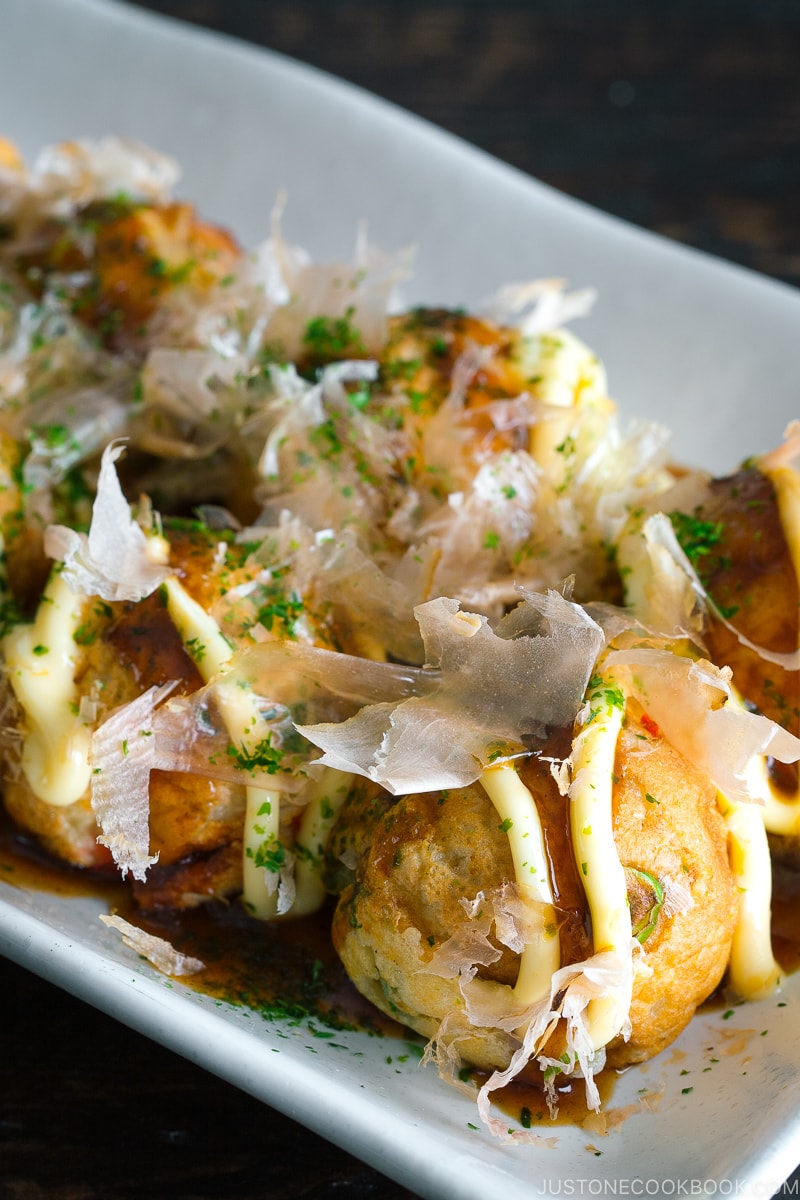
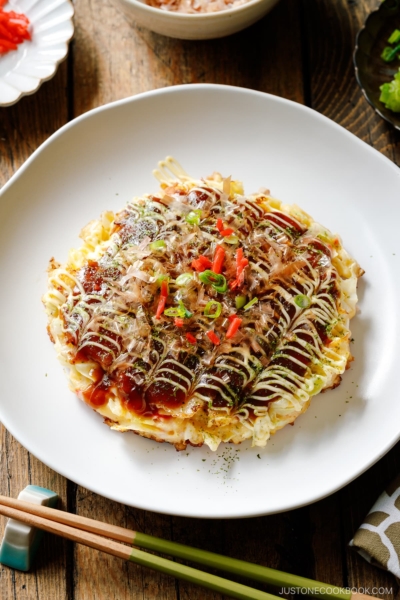
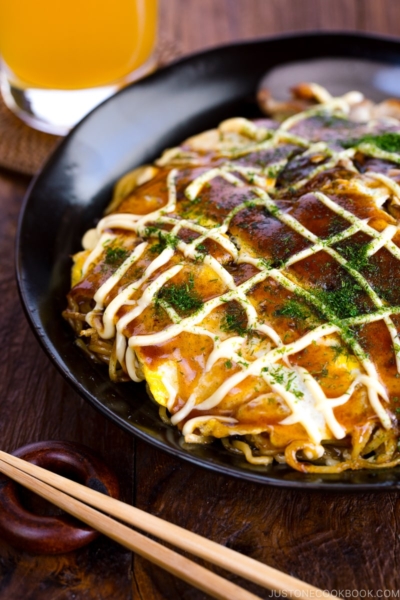
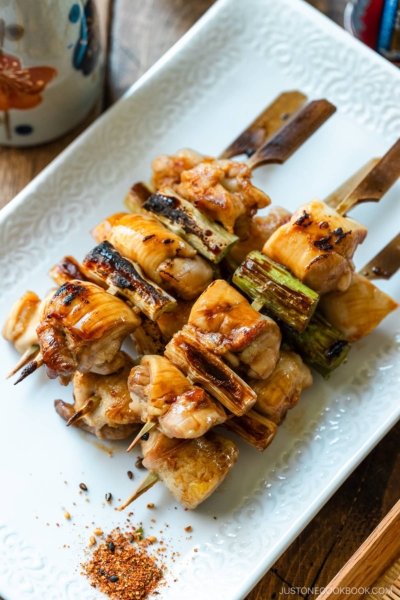
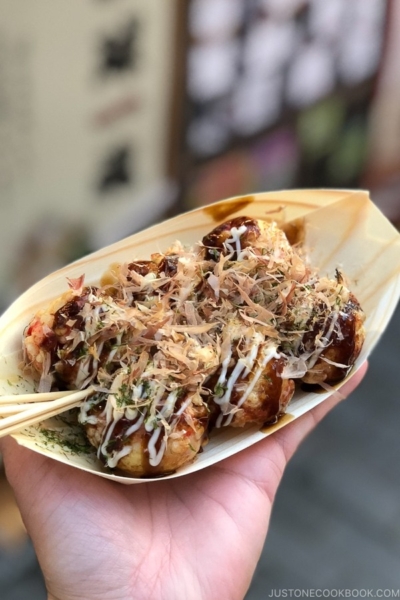





I was so excited to make this.
I went to a town with a huge Uwajimaya Grocery Store and bought all of my ingredients. I simply had to wait for my cast iron takoyaki pan to arrive.
I made it today and I obviously have to work on my turning technique but they came out deliciously. I was worried when I made the batter because it was thin but when I added it to the pan, I understood why. We added shrimp to ours instead of octopus because I didn’t know how long it would take for the pan to arrive and didn’t want the tako to go bad.
I must say that it came out deliciously and my son was very impressed as he’s never had it before.
Nami, you have the best recipes and I’m so thankful that i happened upon your site looking for a green tea ice cream recipe.
Hi Gail! Thank you so much for trying this recipe! Good looking Takoyaki does need some practice (Mr. JOC has more patience than me… and I don’t make often, so I have to say I struggle every time I make!). Takoyaki in Osaka (where it’s from) has various types of dough, some are rare, some are more doughy, etc… The thinner the batter is, the harder it is to make, but it makes excellent takoyaki. It seems like you did an excellent job! Thanks so much for taking the time to write your feedback. I truly appreciate it! xo
hi-
curious: what’s in the little bottle with the green label in the ingred. list?
Thanks!
oops, it’s aonori!
That’s correct. 🙂
Hey!
I made the takoyaki for dinner yesterday with a seaweed salad and onigiri. They were great! Being my first time, I did run into some issues:
It didn’t click with me if this is what you were saying, but I had to keep turning the puffs 90 degrees and pouring a little batter in each mold to get them a completely round shape. I also had to make the batter again because I was left with enough octopus to do it all over again. This is partly because my package of octopus slices was just over 4.2 ounces at 4.6.
Using a stovetop takoyaki pan, I ended up doing more like 4 minutes per side and they still didn’t brown enough. I had better results when I 1) turned the heat up to medium-high,
2) added the octopus first,
3) combined the ginger, green onion, tenkasu, and bonito flakes with the batter like I saw done in Japan,
4) filled the pan to a slight overflow,
rotated 90 degrees twice while pouring enough batter to fill just the mold.
I think most of the reason I had a difficult time was because my batter turned put quite liquid and my pan was too small. I just thought I’d post what worked for me in case some other newbies were interested. Adding the octopus first wasn’t my idea, but my partner reminded me we had seen that in Japan, too. It created some lovely browned edges. As is our preference, we also cut the octopus into half-inch pieces (thin because they were already sliced into 1/8 to 1/4 inch thickness) to help with the chewiness.
Hi Maribel! I appreciate you took the time to write here so other JOC readers can read your experience! Thank you so much for your feedback!
Another great recipe, Nami! We loved these! And they were surprisingly easier to make than I thought they’d be. I think I learned a cooking lesson today, that not all salts taste equally salty. I’ve switched to using pink himalayan salt in the kitchen recently, and they turned out quite on the salty side (not enough to be bad, but definitely saltier than I’d like them to be). Luckily the sweetness and umami of the sauce and mayo helped balance this. I see some similar comments of people asking about different kinds of salt and how much to use. Who knew that not all salts taste the same amount of salty? ^ ^”
So if anyone is reading this and is using finely ground himalayan pink salt, I think you’d be safe to go down to 1/4 tsp of it. That combined with the soy sauce should be plenty enough to flavor it.
Hi Lion! Thanks so much for trying this recipe and good to hear from you that this recipe was not as difficult. 🙂
Yeah, salts taste differently. In general, a lot of cooking sites and recipes use kosher salt (and I also use this). To avoid confusion, I also mention in my FAQs that I use kosher salt in my recipes (I don’t own table salt), and recommend to use 1/2 amount of salt if they use “table salt” (but I know, who check FAQs….).
I use sea salt and himalayan pink salt for finishing touch. If the food needs to be cooked, I use kosher salt, like sprinkling salt on chicken or steak. But I finish up the flavor with himayalan pink salt or sea salt. 🙂 I love the flavor of himalayan pink salt too!
Hi, I want to ask something. “Why are you using baking powder here?” I noticed some other recipes don’t use baking powder and it made me really curious. Thanks
Hi ArB! This is the recipe from my friend who makes Takoyaki way more frequently than me (She grew up and lives in Osaka). She always says even Osaka people make Takoyaki differently so it’s up to you if you want to put it in or not. It helps the dough more fluffier (puffier).
luv ur recipe.
Thank you so much!!
Hello nami, this weekend I hope to do takoyaki, but a question arose: why is baking powder added to the dough?
Hi Ruth! I think it helps the dough more fluffier (puffier). 🙂
Hello nami, where I live Japanese salsa are very expensive, so I want to know if tonkatsu sauce tastes very different from takoyaki sauce? I mean, is it worth buying it or can I use a tonkatsu sauce as a multipurpose?
Hi Ruth! I think “salsa” was auto-corrected from “sauce”. 😀 I was thinking what’s Japanese salsa… hehehe.
Have you tried making my homemade sauces? You can use either Takoyaki sauce or Tonkatsu sauce for this recipe.
https://www.justonecookbook.com/tonkatsu-sauce-recipe/
https://www.justonecookbook.com/takoyaki-sauce-recipe/
They are pretty close to the original version as I did side by side comparison to make the recipe. 😀
Hope you enjoy!
Can this Takoyaki recipe be made in advance – night before for next day picnic? Will they get soggy?
Hi Jacquelyn! They do get soggy as they are made of batter, and ingredients inside release some moisture. But… we still enjoy them whenever we have leftovers. Ideally it tastes great at warm temperature or at room temp. When the batter is chilled, it’s harden and not fluffy. Bring to room temperature at least before you enjoy at the picnic. 🙂
Hiya, I just made Takoyaki, but they were very doughy, even after 10 mins of cooking.
It was only the crust that didn’t have that undercooked consistency, so I figured that must be what they’re like. Is that about right?
I made them in the Danish style pan at medium heat.
Thank in advance for your feedback
Hi Camilla! So takoyaki in Osaka have SO MANY variations. Some shops are famous for doughy takoyaki – the dough is still liquidy that it comes out (and super hot when you bite), and some shops serve more cooked. Overall, there is no takoyaki that is completely cooked like pancake. It’s always doughy somewhat – so it’s kind of like fluffy and doughy, not “cakey” per se. I’m not sure how doughy yours were, but you could probably cook a little longer to make sure it’s more solid (?). I like mine to be doughy but easy to separate into two when you bite into it. Hope that helps?
Great recipe! How long can I keep cooked takoyaki (no sauce) in the fridge? Freezer? Thanks!
Hi Judee! Probably up to 2 days in the fridge? The moisture inside the takoyaki will come out, so the texture will not be the same dough. You can freeze it for probably up to a month. 🙂
Hello, I couldn’t find Tenkasu in my local Asian supermarkets. Can I substitute with regular tempura mix?
HI Sianie! Tenkasu is the deep fried batter scrap from tempura mix batter. So you can make tenkasu on your own, using the tempura mix and deep fry them. But it’s an extra work. You can omit tenkasu if you want to make tempura scraps just for this recipe. 🙂
Thank you for the recipe. I have just purchased a takoyaki pan. I can not wait to try it.
Hi Coral! Yay! I hope you enjoy making takoyaki at home! 🙂
What happened to the 2014 recipe with konbucha?
Hi Albert! You can swap ½ tsp kosher salt with kombucha. I basically replaced it as so many people told me they can’t get kombucha (which is understandable).
cook the takoyaki ball last saturday first time not much confident. my daughter said a little over cook (hard). cooking beside ingredients also depend on our skill.
will try again
thank you for sharing your recipe with us.
Hi Margaret! I agree. I don’t normally cook Takoyaki as it’s Mr. JOC’s job. I struggled a lot making it…. practice and patience are necessary…. 🙂 Thank you for your feedback!